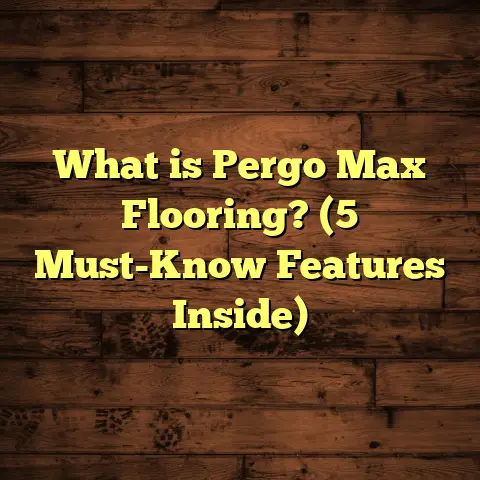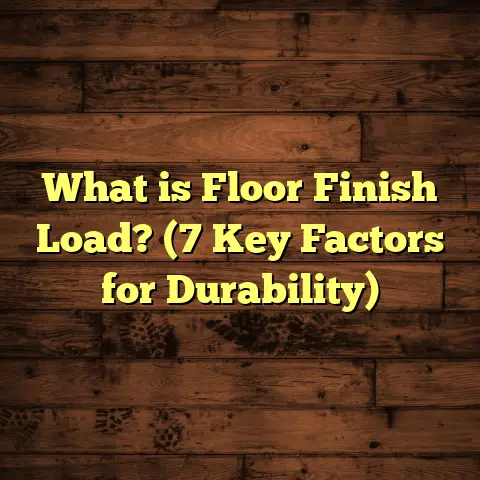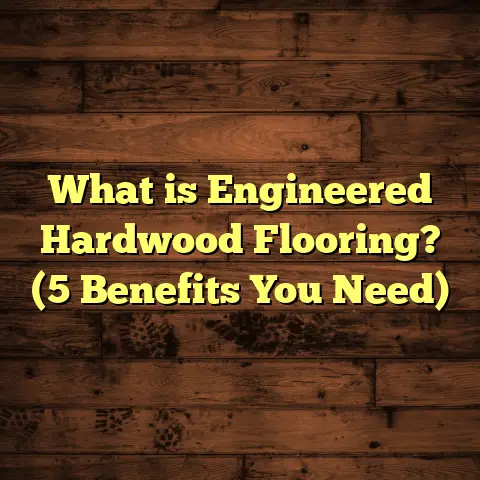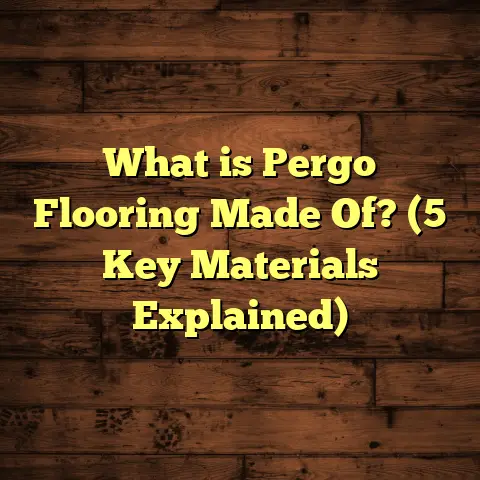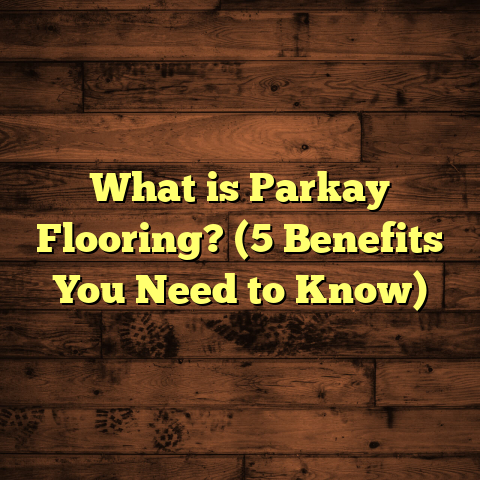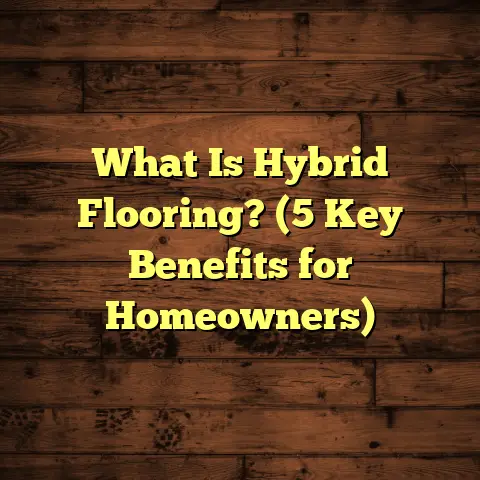What is LVP Vinyl Flooring? (5 Key Benefits You Must Know)
When I first started working with flooring materials, I quickly realized that the secret to a great floor often lies in its layers. Whether it’s hardwood, laminate, or vinyl, each layer contributes to how the floor performs over time. This layering impacts everything from durability and comfort to moisture resistance and installation ease. One floor type that really impressed me with its smart use of layers is LVP vinyl flooring.
I was initially skeptical about how close vinyl could look and feel like real wood. But once I peeled back an LVP plank sample at a supplier’s showroom and examined its layers—core, photographic image, wear layer—I began to appreciate the engineering behind it. That moment marked the start of my journey into understanding what makes LVP vinyl flooring an increasingly popular choice.
What is LVP Vinyl Flooring?
LVP stands for Luxury Vinyl Plank flooring. It’s a type of resilient vinyl flooring designed to mimic natural wood planks but with enhanced practical features. Unlike traditional sheet vinyl that comes in large rolls, LVP consists of individual planks shaped and sized similarly to hardwood boards. This format lets you install it in familiar patterns like straight planks or herringbone, making it visually appealing and versatile.
The Layered Structure of LVP
What truly sets LVP apart is its multi-layer construction. Each plank is made up of several key layers stacked together:
- Backing Layer: This bottom layer provides dimensional stability and sometimes includes an attached underlayment for sound absorption and cushioning.
- Core Layer: Made from PVC or a composite material, this layer gives the plank strength and flexibility. There are several core types—luxury rigid core (WPC or SPC) types offer even more durability and resistance to dents.
- Photographic Film Layer: This is the “wood look” layer—high-resolution images that replicate wood grain and color variations. Advances in printing technology have made these images extremely realistic.
- Wear Layer: The clear topcoat protects the plank from scratches, stains, fading, and daily wear. Thickness ranges from around 6 mils (0.15 mm) for residential use up to 20 mils (0.5 mm) or more for commercial-grade products.
- UV Coating (optional): Some planks have an additional UV-cured coating on top of the wear layer for enhanced durability.
Why Choose LVP Over Other Flooring Types?
When explaining LVP to friends or clients, I often compare it to hardwood and laminate because those are the most common alternatives people consider.
- Hardwood Floors: Beautiful and natural, but expensive and sensitive to moisture and scratches.
- Laminate Flooring: Uses a fiberboard core and photographic surface like LVP but is not waterproof. It can swell or warp if exposed to water.
- Traditional Vinyl Sheets: Often less realistic looking and installed as large sheets rather than individual planks.
LVP combines many of the best qualities: it’s waterproof, durable, easy to install, and visually convincing as wood. Plus, you get more options in textures, finishes, and plank sizes than with laminate.
5 Key Benefits You Must Know About LVP Vinyl Flooring
Through years of installing floors and advising homeowners, I’ve identified five standout benefits of LVP that explain why it’s become my go-to recommendation for so many projects.
1. Durability for Busy Homes and Commercial Spaces
Durability is what sold me on LVP in the first place. I remember installing LVP planks in a family home with three young kids who were constantly running around with sneakers on. After nearly three years, their floor looked fantastic despite the heavy traffic.
The secret is in that wear layer I mentioned earlier. The thicker the wear layer, the better the floor resists scratches from pets’ claws or furniture movement. For homes with pets or kids, I usually recommend a wear layer thickness of at least 12 mils.
According to industry research from the Resilient Floor Covering Institute (RFCI), high-quality LVP with a 12-20 mil wear layer can last 15-20 years in residential settings without significant wear issues if maintained properly.
In commercial spaces like cafes or retail shops where foot traffic is constant, commercial-grade LVP with thicker cores and wear layers can sustain damage much longer than traditional hardwood or laminate floors.
My Personal Experience With Durability
One memorable commercial project was a boutique coffee shop downtown that replaced worn hardwood flooring with SPC core LVP planks. After one year of heavy daily foot traffic combined with occasional spills and dropped items, the owner reported zero damage or fading—a huge win compared to their previous floors.
This durability is partly due to how the vinyl core absorbs impacts without cracking and how the clear topcoat protects against surface scratches.
2. Waterproof Performance for Worry-Free Living
What really makes LVP stand out for me—and many others—is its waterproof nature. Unlike hardwood or laminate floors that can swell, warp, or rot when exposed to water, LVP stands strong even in wet environments.
I installed LVP in a basement apartment prone to occasional flooding due to heavy rains last year. Despite water pooling for several hours in certain areas during storms, the floor showed no signs of damage afterward.
Scientific testing backs this up: vinyl planks with waterproof cores resist moisture penetration completely for extended periods (typically 24+ hours), which means spills or leaks won’t ruin your floor as they might with wood products.
Real-Life Examples
- Kitchens are notorious for spills and occasional water splashes. Many homeowners now prefer LVP here because it stays intact even if water sits briefly on the surface.
- Bathrooms used to be off-limits for hardwood flooring but are perfect for LVP given its moisture resistance.
- Laundry rooms, mudrooms, and basements benefit similarly because these areas often have higher humidity or water exposure.
I’d say if you want flooring that handles life’s little accidents without panic, LVP is an excellent bet.
3. Quick and Simple Installation Saves Time and Money
I’ve been on countless flooring jobs where installation time dragged on because of complex prep or sticky adhesives. With LVP, installation is often straightforward thanks to click-lock systems or loose lay options that don’t require glue or nails.
The floating floor method means you’re simply snapping planks together over an existing subfloor (with minor prep). This saves labor hours and reduces mess—one reason DIYers love it too.
Recently, I relied on FloorTally to help me estimate total costs on a multi-room LVP project accurately. The tool allowed me to enter room dimensions and select specific plank types to calculate material needs precisely—including waste factors—which prevented overbuying or last-minute orders.
This saved me considerable time coordinating materials and gave my client peace of mind about the budget before installation started.
Installation Tips From My Experience
- Always check the subfloor for levelness before laying LVP; uneven surfaces can cause gaps or plank movement.
- Leave a small expansion gap around walls since vinyl can expand or contract slightly.
- Use proper underlayment if recommended by manufacturer for sound absorption or added comfort.
- If you’re unsure about cutting planks precisely around corners or fixtures, take your time; mistakes can be costly.
The ease of installation combined with cost transparency tools like FloorTally really helps keep projects smooth and predictable.
4. Comfort and Quietness Underfoot
When I first walked on an LVP floor compared to tile or hardwood, I noticed it was much softer underfoot—and quieter too. The layered construction helps absorb sound and reduce impact noise, which makes a big difference in busy households or apartments.
One client told me they switched from tile to LVP in their kitchen because standing on tile all day made their feet ache. The cushioned feel of vinyl planks reduced fatigue noticeably.
Sound absorption is also key in multi-story buildings where noise travels easily through floors. Some premium LVP products include attached cork underlayment which further dampens footsteps.
Why This Matters
Comfort isn’t just about feeling nice—it can affect how long you can stand or work in a room without discomfort. In workspaces like home offices or playrooms where you spend hours on your feet, this cushioning can be a game-changer.
5. Style Variety That Fits Every Taste
If you’re like me when choosing floors—you want them to look amazing while still being practical—you’ll appreciate how far design has come in LVP flooring.
The photographic layers are incredibly detailed now. You can find planks imitating everything from reclaimed barn wood with rough textures to smooth maple or even exotic species like teak or mahogany.
Plank widths range from narrow strips (3” wide) up to wide planks (7” or more), giving designers flexibility to create different visual effects. Some manufacturers add beveled edges that replicate traditional hardwood board seams perfectly.
Trends I’ve Noticed
Recently, wider planks with matte finishes have become popular because they look more natural and less “shiny.” Also, distressed wood looks add character without compromising durability.
When I worked on a rustic cabin renovation last year using distressed oak-look LVP planks, the client was amazed at how authentic it felt—yet they knew they had a floor far easier to maintain than real wood in such an environment.
Detailed Data on Costs and Maintenance
You’re probably wondering about cost versus value here. From my experience and research:
- Material Costs: Mid-range LVP typically costs between $2-$5 per square foot depending on brand and thickness.
- Installation Costs: Professional installation adds roughly $1.50-$3 per square foot; DIY reduces this but requires skill.
- Maintenance Costs: Minimal compared to hardwood—regular sweeping/mopping keeps it clean; no refinishing needed.
Using FloorTally has helped me keep these numbers tight when budgeting for clients by factoring in local labor rates alongside material prices automatically.
Maintenance Tips From My Projects
- Avoid abrasive cleaners; mild soap solutions work best.
- Use felt pads under furniture legs to prevent scratches.
- Quickly wipe up spills to protect aesthetics.
- Periodically check for loose planks or gaps as floors age.
Case Studies From My Work
Case Study 1: Family Home Kitchen Renovation
Installed 800 sq ft of 12 mil wear-layer LVP in an open-concept kitchen/dining area with underfloor heating. Client loved how warm and comfortable the floor felt compared to tile previously installed. After 18 months of use with kids’ spills and pets’ claws, the floor showed no visible damage.
Case Study 2: Boutique Retail Store Flooring
Replaced worn hardwood flooring with SPC core commercial-grade LVP for better durability under heavy foot traffic. Installation took two days instead of five estimated for hardwood replacement. Maintenance costs dropped by around 30% annually due to less damage needing repair.
Case Study 3: Basement Apartment Waterproof Flooring
Installed waterproof WPC core LVP across 900 sq ft basement unit prone to moisture issues. After two wet winters with minor flooding events, no signs of warping or mold growth appeared—client praised peace of mind alongside stylish finish.
Final Thoughts From My Flooring Journey
LVP vinyl flooring has become one of my favorite materials because it strikes a balance between style and function that few others do well. Its layered design delivers strength against scratches and moisture while offering realistic wood looks at a fraction of hardwood’s cost.
Whether you’re renovating a busy family home, outfitting a commercial space, or finishing a tricky basement area, LVP deserves serious thought as your flooring solution.
Have questions about choosing the right thickness? Installation tips? Cost estimates? Or curious about how tools like FloorTally can simplify your planning? Just ask—I’m happy to share what I’ve learned over years of working closely with this versatile flooring option!
